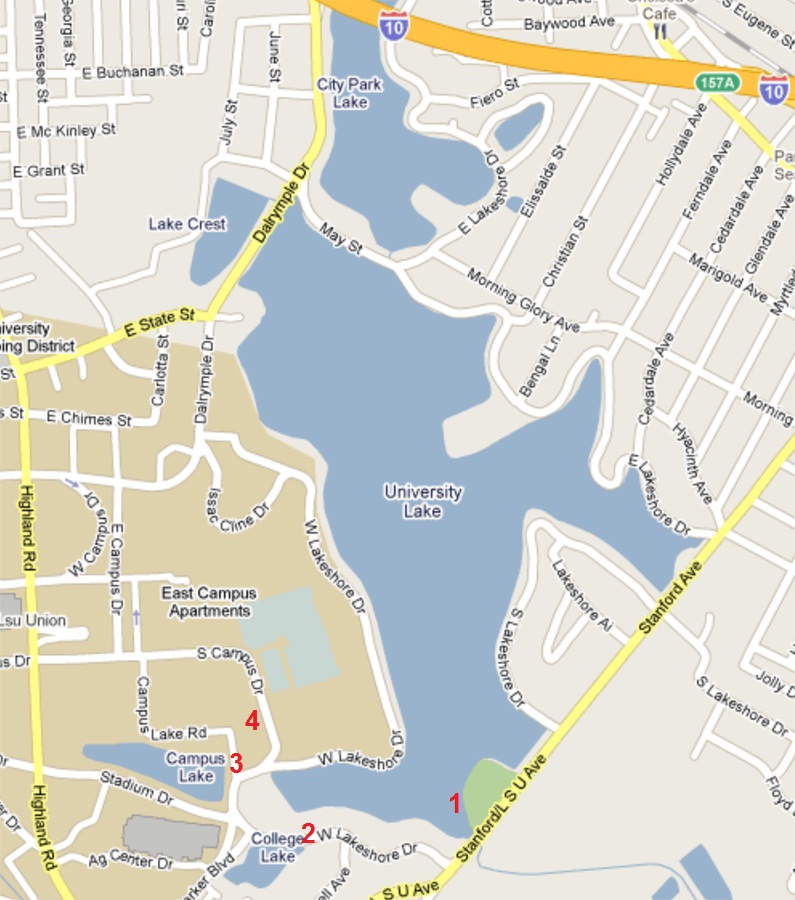Chapter 2. ECOSYSTEM ECOLOGY— AQUATIC I—SAMPLING
Learning Objectives
General Purpose
Conceptual
- Be able to determine the change in an ecosystem caused by either biotic or abiotic factors.
- Gain an understanding of the factors that influence the level of dissolved oxygen in an ecosystem and understand the importance of dissolved oxygen.
Procedural
- Be able to properly sample aquatic ecosystems.
- Be able to extract and measure chlorophyll levels in aquatic ecosystems.
General Purpose
The University Lake system is a five-lake system (see Figure 5-2) that comprises 300 acres. The system is part of a watershed that takes in water from the surrounding area and also discharges water into Bayou Duplantier.


The health of this aquatic system can fluctuate based on a number of influences, and fish kills have occurred periodically in the past, especially during the warm summer months.
When assaying the health of an ecosystem, ecologists are often interested in the abiotic or biotic factors that may be limiting in an ecosystem. The limiting component can determine the carrying capacity of populations in the ecosystem. In turn, the health and size of the individual populations of the community in the ecosystem can impact the abiotic factors. The limiting factor(s) will differ between species and potentially over time. Thus, ecosystem ecologists are often concerned about how the abiotic factors (nutrients) vary over time.
Since assaying these factors once will provide only a snapshot view of the ecosystem, you will need to compare your measurements to past measurements. These comparisons will allow you to gauge if there are any changes occurring in the ecosystem and if there is a discernible pattern to those changes.
Some of the abiotic factors include depth, water clarity, temperature, pH, nitrogen cycle components (nitrate, nitrite, ammonia), phosphorus, and dissolved oxygen levels. Possible biotic factors include autotrophs (measured through chlorophyll levels and dissolved oxygen production) and heterotrophs (detected together with autotrophs by dissolved oxygen usage).
Abiotic Factors
Depth: Very shallow lakes such as the LSU lake system can have water quality issues based on the fluctuation of temperature and the overgrowth of vegetation.
Clarity: Water clarity affects how deep sunlight can penetrate. This directly affects how much of the water is available for the growth of light-dependent autotrophs. Heterotrophs may survive in water with low clarity by surviving on other heterotrophs and autotrophs that die and drift downward.
Temperature: All living organisms have limited temperature ranges for survival. The water temperature directly affects metabolic rates and the chemical solubility affecting nutrient availability, and therefore has an impact on the growth rates of many organisms (e.g., cooler water can hold more dissolved oxygen).
pH: Aquatic organisms are directly dependent upon the water’s pH due to their own pH sensitivities and indirectly as pH affects the solubility of many nutrients and toxins.
Nitrogen Cycle Components: Nitrogen moves through the ecosystem in multiple chemical forms with various levels of bioavailability.
Ammonia (NH4+): Nitrogen-fixing bacteria convert nitrogen gas to ammonia, which can then be converted to the form used by plants. Ammonia results from metabolic waste and bacterial decay of organic material. Nitrogen fertilizers introduce ammonia into the environment.
Nitrite (NO2): A short-lived form of nitrogen intermediate between ammonia and nitrate. Chemotrophic bacteria convert ammonia to nitrite, and then other species of bacteria convert nitrite to nitrate.
Nitrate (NO3): The form of nitrogen that is usable by plants, where it can be converted to nitrogen-containing amino acids for use by heterotrophs.
Phosphate: Phosphate is an essential nutrient for both heterotrophs and autotrophs. Phosphate is often the limiting nutrient in freshwater systems. Natural levels of phosphate are 0.05 mg/mL. Poor water quality in many lakes and aquatic ecosystems is partly due to accumulated phosphate in the bottom sediments. Excessive phosphate can result in excessive algae growth (algae blooms) which is one cause of the fish kills the University Lake system periodically experiences. Algae blooms can release toxins, block sunlight, thus reducing lake autotrophs, and reduce dissolved oxygen. Phosphate occurs naturally in rocks and soil. Sources of excess harmful phosphate are fertilizers, animal feed, animal waste, and sewage.
Dissolved Oxygen: The availability of dissolved oxygen in an ecosystem can determine whether many heterotrophs can survive. Low levels of dissolved oxygen result in the death of heterotrophs, including fish. Oxygen is produced by autotrophs and is used by autotrophs and heterotrophs. Decomposition of organisms can lead to oxygen depletion in aquatic systems. While low levels of dissolved oxygen can result from many causes, it is one of the direct causes for fish kills.
Biotic Factors
Chlorophyll: Chlorophyll is found in the lake system autotrophs, including aquatic plants, cyanobacteria, and archaeans. Chlorophyll can be used as a relative measure of autotrophic concentration.
Oxygen Use: Oxygen consumption and oxygen production are indirect measurements of heterotrophs and autotrophs present in the ecosystem. These are measured experimentally by comparing dissolved oxygen use and production over time with or without light.
The focus of the lab is three of the lakes and a bayou (part of the watershed) adjoining the LSU campus. Working in groups your lab will collect and analyze samples from four sites. Data collected by your lab will be shared not only with other sections, but also with future students, who will collect data at these same sites.